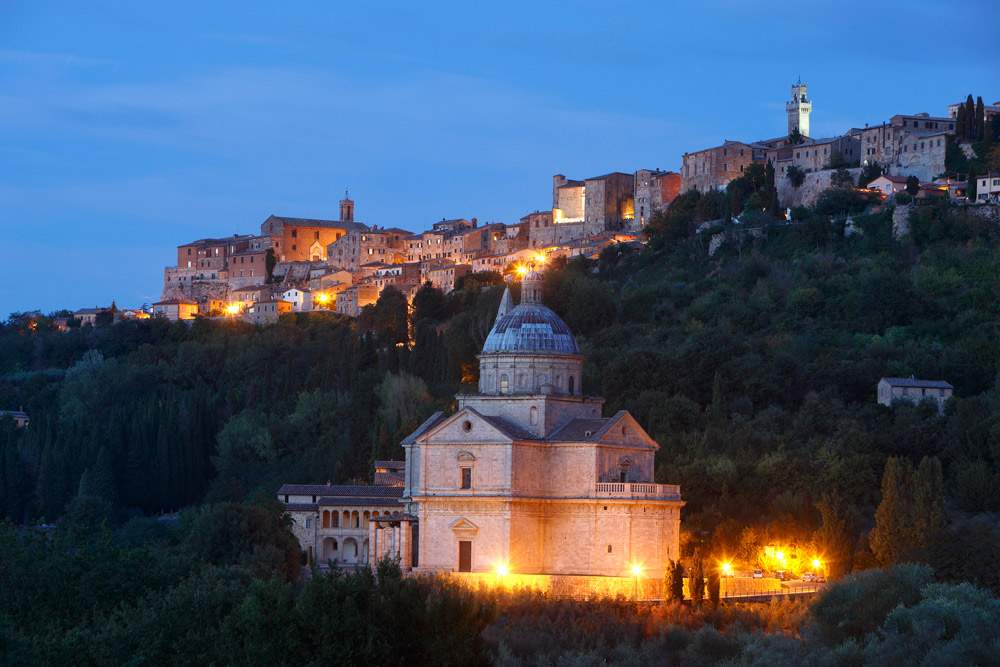Montepulciano, the temple of San Biagio celebrates five hundred years with a major exhibition
The highlight of the 500th anniversary of the Temple of San Biagio in Montepulciano is scheduled from April 22 to November 4, 2018: it is the exhibition The Temple of San Biagio in Montepulciano after Antonio da Sangallo. History and Restoration, which celebrates one of the greatest masterpieces ofRenaissance architecture. In fact, the Pisan temple was built to a design by Antonio da Sangallo the Elder (Florence, 1455 - 1534) between 1518 and 1548 (thus even after the death of its author: in particular, the dome was built between 1543 and 1545, while the first bell tower dates from 1564, and the second is still unfinished), and the exhibition, curated by Laura Martini and RiccardoPizzinelli (here is Finestre sull’Arte’s interview with Riccardo Pizzinelli) intends to re-propose to the visitor the original interior decoration of the church, which was made starting from the last four of the sixteenth century, with the rules on liturgical apparatus and sacred art issued by the Council of Trent. In fact, the temple was then heavily remodeled during the nineteenth century, when a Renaissance restoration completely changed its interior.
The temple of St. Blaise, with a central plan, and like the adjacent rectory made entirely of travertine from the nearby St. Albino quarries, has been the subject of studies that have emphasized its harmonious use of orders, architectural parties and classical proportions, in a relationship between man, architecture and landscape. The temple, begun in September 1518 after some miraculous events occurred in Montepulciano in April that led citizens to want to build a house of worship dedicated to St. Blaise: it was then consecrated in 1537.
“The exhibition event,” we read in the presentation of the exhibition, “intends to draw attention to this little-known chapter in the events of San Biagio: the forgotten history of the interior decoration of the temple, built between the end of the 16th century, at the time of the Counter-Reformation, and the height of the 17th century, with the establishment of Baroque eloquence. The current, classical, interior configuration dates, in fact, from the ’purist’ recovery of the late nineteenth century with the altars rebuilt in the sixteenth-century style on the example of the only one that has been believed to have been executed on an original design by Sangallo in the first half of the sixteenth century (the first one in the left arm with the painting of the Annunciation). The interior renovation project involved the six side altars with an exuberant ornamentation of volutes, coats of arms and putti in painted and gilded stucco, enclosed within the rose archway and the canvases housed in them. A number of famous lineages (Cervini, Contucci, Nobili, Ricci, and Lupacci), who were assigned the patronage of the chapels and altars, contributed greatly to this intervention, which radically altered the Renaissance spaces. Noble Polizian families linked predominantly to the Roman and Florentine artistic milieu, as evidenced by the canvases of the altars and the mural paintings that stand out in the presbytery area.”
It was in the 1880s, after San Biagio was proclaimed a national monument in 1878, that the neo-Renaissance restoration began, based on a design by Giuseppe Partini (Siena, 1842 - 1895): the restoration also involved the relocation of the large seventeenth-century canvases, which were transferred to churches in the city and the territory. The altars remained empty until 1904, when some Florentine galleries lent paintings from their deposits, later returned in 1973. Also on display is a documentary section with images, paintings, engravings, plans and elevations of the interior, and documents related to the demolition of the 17th-century altars and the construction of the new ones.
Viewing hours: April 22 to May 31 from 10 a.m. to 6 p.m., June 1 to September 30 from 9:30 a.m. to 6:30 p.m., October 1 to 31 from 10 a.m. to 6 p.m. (daily), November 1 to 4 (Saturdays and Sundays only) from 10 a.m. to 12 p.m. and 3 p.m. to 5 p.m. Admission fee: €3.50 full price with audio guide available in Italian, English, French, German and Spanish. Free for children under six, residents of the municipality of Montepulciano, disabled, clergy, journalists, authorized tour guides. Info and reservations at 0577 286300 or www.tempiosanbiagio.it. The exhibition is promoted and organized by the owner body, Opere Ecclesiastiche Riunite di Montepulciano, the Diocese of Montepulciano-Chiusi-Pienza, the Soprintendenza Archeologia Belle Arti e Paesaggio of the Provinces of Siena, Grosseto and Arezzo, the Municipality of Montepulciano, the Biblioteca Archivio Piero Calamandrei, with the contribution of the Consorzio del Vino Nobile di Montepulciano and the intervention of Cattolica Assicurazioni, and is produced by Opera-Civita.
Image: the temple of San Biagio with, in the background, the town of Montepulciano.
 |
| Montepulciano, the temple of San Biagio celebrates five hundred years with a major exhibition |
Warning: the translation into English of the original Italian article was created using automatic tools. We undertake to review all articles, but we do not guarantee the total absence of inaccuracies in the translation due to the program. You can find the original by clicking on the ITA button. If you find any mistake,please contact us.




























